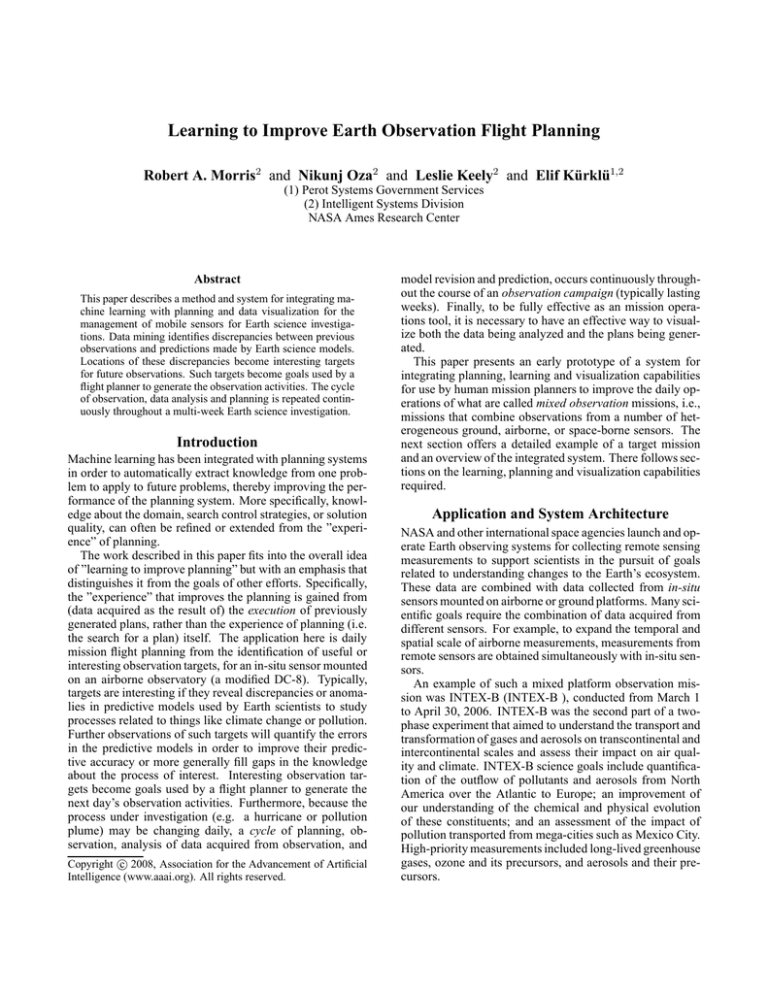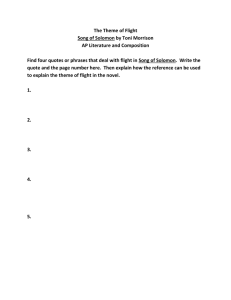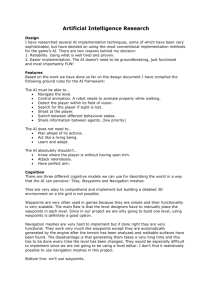
Learning to Improve Earth Observation Flight Planning
Robert A. Morris2 and Nikunj Oza2 and Leslie Keely2 and Elif Kürklü1,2
(1) Perot Systems Government Services
(2) Intelligent Systems Division
NASA Ames Research Center
Abstract
This paper describes a method and system for integrating machine learning with planning and data visualization for the
management of mobile sensors for Earth science investigations. Data mining identifies discrepancies between previous
observations and predictions made by Earth science models.
Locations of these discrepancies become interesting targets
for future observations. Such targets become goals used by a
flight planner to generate the observation activities. The cycle
of observation, data analysis and planning is repeated continuously throughout a multi-week Earth science investigation.
Introduction
Machine learning has been integrated with planning systems
in order to automatically extract knowledge from one problem to apply to future problems, thereby improving the performance of the planning system. More specifically, knowledge about the domain, search control strategies, or solution
quality, can often be refined or extended from the ”experience” of planning.
The work described in this paper fits into the overall idea
of ”learning to improve planning” but with an emphasis that
distinguishes it from the goals of other efforts. Specifically,
the ”experience” that improves the planning is gained from
(data acquired as the result of) the execution of previously
generated plans, rather than the experience of planning (i.e.
the search for a plan) itself. The application here is daily
mission flight planning from the identification of useful or
interesting observation targets, for an in-situ sensor mounted
on an airborne observatory (a modified DC-8). Typically,
targets are interesting if they reveal discrepancies or anomalies in predictive models used by Earth scientists to study
processes related to things like climate change or pollution.
Further observations of such targets will quantify the errors
in the predictive models in order to improve their predictive accuracy or more generally fill gaps in the knowledge
about the process of interest. Interesting observation targets become goals used by a flight planner to generate the
next day’s observation activities. Furthermore, because the
process under investigation (e.g. a hurricane or pollution
plume) may be changing daily, a cycle of planning, observation, analysis of data acquired from observation, and
c 2008, Association for the Advancement of Artificial
Copyright Intelligence (www.aaai.org). All rights reserved.
model revision and prediction, occurs continuously throughout the course of an observation campaign (typically lasting
weeks). Finally, to be fully effective as an mission operations tool, it is necessary to have an effective way to visualize both the data being analyzed and the plans being generated.
This paper presents an early prototype of a system for
integrating planning, learning and visualization capabilities
for use by human mission planners to improve the daily operations of what are called mixed observation missions, i.e.,
missions that combine observations from a number of heterogeneous ground, airborne, or space-borne sensors. The
next section offers a detailed example of a target mission
and an overview of the integrated system. There follows sections on the learning, planning and visualization capabilities
required.
Application and System Architecture
NASA and other international space agencies launch and operate Earth observing systems for collecting remote sensing
measurements to support scientists in the pursuit of goals
related to understanding changes to the Earth’s ecosystem.
These data are combined with data collected from in-situ
sensors mounted on airborne or ground platforms. Many scientific goals require the combination of data acquired from
different sensors. For example, to expand the temporal and
spatial scale of airborne measurements, measurements from
remote sensors are obtained simultaneously with in-situ sensors.
An example of such a mixed platform observation mission was INTEX-B (INTEX-B ), conducted from March 1
to April 30, 2006. INTEX-B was the second part of a twophase experiment that aimed to understand the transport and
transformation of gases and aerosols on transcontinental and
intercontinental scales and assess their impact on air quality and climate. INTEX-B science goals include quantification of the outflow of pollutants and aerosols from North
America over the Atlantic to Europe; an improvement of
our understanding of the chemical and physical evolution
of these constituents; and an assessment of the impact of
pollution transported from mega-cities such as Mexico City.
High-priority measurements included long-lived greenhouse
gases, ozone and its precursors, and aerosols and their precursors.
Day-to-day DC-8 flight planning on INTEX-B was a process of generating a set of flight legs between waypoints (the
flight plan). Plan generation was partly automated using
various flight planning tools that assist the human user by
accounting for flight dynamics of the DC-8 and other constraints. Selection of waypoints was guided by forecasts
generated from a set of models of different spatial scales.
Near-real-time observations from a number of satellite instruments were used to guide the selection of and to identify
specific regions of interest for in-situ sampling. Integration
of aircraft and satellite measurements to address the mission
objectives requires validation flights directed at establishing
the consistency between the two data sets.
The focus of automation in the context of mixed observation missions such as INTEX is to improve the ability to assimilate the different data sources in order to generate waypoints; and secondly, to automate the search for high quality
plans, where quality is related to the ability to resolve model
anomalies or accomplish other mission goals. The idea is
that improved data assimilation will result in a better understanding of the space of high quality flight plans, a space
which can be then explored more effectively by automated
planning methods.
The semi-closed system integrating machine learning
with flight planning into a daily mission planning system
is visualized in Figure 1. The system involves four components:
1. Data archives, process models, and instruments for producing data or forecast products (commonly referred to
as a ”sensor web”).
2. A data assimilation assistant for generating planning
goals (waypoints) given data;
3. A flight planning assistant for generating flight plans
given goals; and
4. A visualization tool for displaying the data and plans to
the human mission planners or domain scientists.
For example, a process model produces Carbon Monoxide (CO) distribution predictions for a specified region,
which are assimilated with satellite observations of CO from
remote sensors over the same region, such as Aurora and
Ionospheric Remote Sensing (AIRS) and Measurements of
Pollution in the Troposphere (MOPITT) sensors, as well as
observations of dust, aerosols and clouds from the Moderate Resolution Imaging Spectroradiometer (MODIS). These
data and models are organized and archived. As a result of
data mining, waypoints, expressed in a 3D location vector,
hlatitude, longitude, altitudei and a value indicating priority, are identified as interesting locations for conducting
future CO measurements, either for finding and characterizing differences between models and observations, or for
filling in gaps in data. The waypoints are fed into the planner as goals. Flight plans are generated and displayed to the
human planner using the visualization tool. Measurements
are taken, and the cycle is repeated, usually on a daily basis.
The remaining sections focus on the learning, planning,
and visualization challenges that arise in this application.
Figure 1: The daily mission flight planning cycle, integrating machine learning, visualization and flight planning.
Learning Problem
As indicated above, the data assimilation assistant generates
waypoints for planning. The waypoints are intended to represent locations where the data is most surprising or ”interesting”. For example, ”interesting” could mean that instruments intended to measure the same quantity yield significantly different measurements, or that models that predict a
certain quantity yield predictions significantly different from
measurements by instruments that measure the same quantity, or mathematical relationships expected to hold between
various models and measurements do not hold. So far, we
have mainly experimented with measuring surprise using the
second metric—differences between model predictions and
measurements—and will report on these in the limited space
that we have. We have done some preliminary investigations
into the third metric—mathematical relationships between
models and various measurements—however, we need to
experiment further with selecting the right subsets of data
over the right time periods and adjusting appropriate tuning
parameters in order to obtain a reasonable set of waypoints.
We compared a model prediction of carbon monoxide (CO) with two satellite measurements of CO. The
process model that we used was the Model of OZone
And Related chemical Tracers (MOZART) (Brasseur et al.
1998a),(Brasseur et al. 1998b). MOZART predictions were
compared with datasets of data acquired by the AIRS and
MOPITT remote sensors. The MOZART predictions are
placed in a regular coarse grid (with each grid cell covering
0.7059 degrees latitude and 0.7031 degrees longitude). The
AIRS and MOPITT instruments take their measurements
in swaths because of the satellites’ orbits around the Earth
(the swaths can be compared to a ribbon being wrapped
around a sphere). Therefore, the measurements end up in
data products as a large number of measurements at various points within a swath. We then selected the points in
all three datasets that fell within the region of interest—
between 12 and 32 degrees north latitude and between 80
and 105 degrees west longitude—which contains Mexico
and the surrounding area. Altitude-wise, we selected the
portions of AIRS and MOPITT that fell within the range
present in MOZART— from the Earth surface to approximately 43 kilometers. We ended up retaining 131474 AIRS
measurements and 14250 MOPITT measurements.
For each of these AIRS and MOPITT measurements, we
then found the closest MOZART point and calculated the
difference between the CO measurement and the MOZART
CO prediction in units of parts per billion. We then converted the resulting 131474 AIRS-MOZART differences
into priorities on a scale of 1 to 10 for input into the planner by simply linearly scaling the absolute differences into
this range. We retained the 50 points with highest priorities
such that the points were a minimum of 58 kilometers (approximately 10 minutes of DC-8 flight time) apart. We did
this because the instrument had the constraint that it needed
at least 10 minutes of measurement time around a waypoint
in order to obtain a clear measurement. Planning for multiple waypoints that are close to one another while still satisfying the time constraint would have required a flight plan
with excessive turns. The way we selected the 50 points was
simply by first selecting the highest priority waypoint, removing all the waypoints less than 58 kilometers away from
this highest-priority point, selecting the remaining waypoint
of highest priority, removing all the waypoints less than 58
kilometers away from this waypoint, etc., until we obtained
50 points. We separately repeated this process of selecting
50 waypoints from the 14250 MOPITT-MOZART differences. We restricted ourselves to 50 waypoints to limit the
planner’s execution time. If we had only retained the constraint on minimum distance between waypoints, we would
have had 302 AIRS-MOZART waypoints and 91 MOPITTMOZART waypoints.
It could be argued that the Flight and Activity Planning
Assistant should perform the selection of waypoints based
on the minimum distance between waypoints, since this is
an instrument-related constraint. This way, there would be
a clear division of responsibility with the Data Assimilation Assistant processing data, and the Flight and Activity Planning Assistant dealing with flight and instrumentrelated constraints. Our decision here was based purely on
efficiency—because the waypoint selection function is distinct from the planning algorithm, and the Data Assimilation
Assistant produces the waypoints and has them in memory,
selecting the appropriate waypoints here is faster.
We also experimented with standard unsupervised learning methods for clustering (K-means (MacQueen 1967) and
kernel clustering (Girolami 2001)) and anomaly detection
(one-class Support Vector Machines (Tax, Ypma, & Duin
1999)). Clustering methods organize the data into clusters
that represent data that have similar properties (e.g., particular ranges in which different measurements fall or particular mathematical relationships between measurements).
Data that are part of very small clusters or are far from all
the clusters represent possible anomalies that may need to
be assessed. Anomaly detection methods construct a model
of the training data, which is typically assumed to be nor-
mal. These methods are then executed on new data, and data
that do not fit the model’s definition of normality are flagged
as anomalous. For example, one-class Support Vector Machines (SVMs) are given training data z1 , z2 , . . . , zn , as well
as an expected fraction of training points that are anomalous.
One-class SVMs find a nonlinear model that identifies up to
that fraction of training points as anomalous and separates
them from the normal points. When a one-class SVM is
given a new point z, it returns a value y that is positive if z is
part of the normal regime identified in the training data and
negative if z is thought to be abnormal. The farther away y
is from zero, the “more normal/abnormal” z is.
However, assessing the points returned by these methods
to determine if they represent true anomalies is more difficult than assessing the points with high differences as we
have mainly done so far. The differences are measured in
units familiar to domain experts (parts per billion), whereas
distances from cluster centroids (for clustering methods) and
distances from hyperplanes (for one-class SVMs) do not
have clear interpretable semantics. The domain expert may
have to directly examine the points flagged by these more
sophisticated methods in the hope of being able to figure out
the nature of the anomalies that the methods have flagged.
This has limited our experimentation with clustering and
anomaly detection methods so far. Additionally, we need
to experiment with different subsets of data products covering different periods of time and with tuning parameter
adjustment in order to yield a reasonably large set of waypoints. In spite of these difficulties, this work is ongoing
because of these methods’ ability to characterize anomalous
relationships between variables even though the variables
themselves may be in the correct range. We expect that these
methods will find waypoints not found using methods typically used by domain scientists.
Planning Problem
There are two kinds of inputs to the flight planner: mission
goals and waypoints. Mission goals arise from models, from
a phenomenon or event of interest, or from other sensing resources. The goal might be to validate predictions made by
a model, to characterize or classify the composition of dynamic process like a pollution plume, or validate observations made by a remote sensing instrument. The waypoints
are 3D specifications of locations that support one or more
of the goals, generated from the data assimilation assistant
just described. Goals or waypoints are assigned priorities
indicating importance.
The output of the flight planner is a flight plan, a closed
path comprised of a set of segments, or flight legs, connecting waypoints. A path is also associated with temporal information (start time of each leg, and duration). Each leg
follows a pattern: direct ascent, direct descent, level, or spiral (ascent or descent). The best path is the one the planner
has determined most likely to satisfy the most goals, based
on the specified priorities.
There are four kinds of constraints on solutions generated
by the planner.
1. Instrument Constraints. Instruments must be set up be-
fore they can take measurements. This means two things:
for the aircraft to assume a certain flight pattern, and to
remain in this pattern for a specified duration of time.
2. Aircraft Constraints. The DC-8 has flight requirements
related to its navigational capabilities, or for safe flying.
3. Path Constraints. Flight paths must satisfy certain logistical constraints, such as starting and end at the same location. Another important constraint of this type is the
avoidance of Special Use Airspace (SUA).
4. Mission Goal Constraints. Certain flight segments are required by the goals of the missions themselves. Typically
these goals involve inter-comparison of data acquired by
different sensors. For example, as noted, on INTEX, the
data acquired by the in-situ sensor on the DC-8 was often
compared by remote sensing data acquired for the same
region at the same time, so the DC-8 was required to fly
along the same track as that flown by the remote sensor.
The core computational problem being solved by flight
planning can be viewed as the orienteering problem (OP)
(Fischetti, Gonzalez, & Toth 1998). Formally, given a set of
waypoints, W = {x0 , x1 ...xn } each with an assigned priority wi , 1 ≤ i ≤ n, a binary cost function C : W ×W → N , a
designated start point x0 with w0 = 0, and a temporal bound
B, find a sequence (schedule) s = hxs1 , ..., xsk i, sj ∈
{0, . . . , n}, k ≤ n + 1, that maximizes Σj=1...k wsj , subject
to the following constraints:
1. s1 = sk = 0,
2. i 6= j → si 6= sj , i.e., each xj ∈ W occurs at most once
in s,
3. Σi=2...k C(xsi−1 , xsi ) ≤ B.
Notice that in this version there is an assumption of ”oversubscription”: it is not necessary, and may not be possible,
to service all the waypoints, and indeed a best route might
not include all of them.
A constructive approach to flight planning was used,
where each decision point involves selection of the next goal
to add to a partial schedule. A greedy stochastic approach to
extending a partial solution is employed, where each feasible
waypoint candidate xi is heuristically evaluated in terms of
the expected value vi of adding a leg terminating at xi to the
partial plan. The heuristic value biases the random selection
process in favor of that candidate, similar to the Heuristic
Biased Stochastic Sampling (HBSS) technique employed in
(Bresina 1996). The purpose of injecting non-determinism
into the solver is to be able to generate multiple solutions for
comparative evaluation by the human planners.
We define vi = wi /[C(xsj , xi ) + pj,i ], where xsj was the
last waypoint added to the schedule, and pj,i is a penalty for
SUA intrusion. A candidate xi is feasible for a partial schedule hxs1 , . . . , xsj i if the sequence hxs1 , . . . , xsj , xi , xs1 i
satisfies the bound constraint (3), i.e., if the aircraft can return to the airport immediately after flying to the waypoint
without violating (3). The algorithm deterministically selects the candidate with the highest expected value to extend
a plan, until either the list of available candidates is empty,
or none of the remaining candidates is feasible with respect
to the current plan.
The flight planning algorithm can be described as follows:
Flight Planner
While there are observations left to schedule
1. Greedily select next observation to schedule:
For each unscheduled observation
Evaluate cost of adding the observation to
the schedule, including the need to avoid SUAs.
2. Add enabling leg
Check altitude constraints
Find path to avoid SUA incursions, if necessary
Check to ensure resulting schedule does not violate
flight duration constraints.
3. Add observation leg (same steps as in 2.)
Add a flight leg to return to origin.
return plan
For each waypoint in the input to the problem, the planner
computes the expected value vi , described above, and (nondeterministically) greedily selects the observation with the
highest such value. An enabling leg is added to the plan,
which is the shortest path to get to the observation point.
The leg must not violate altitude, duration, or SUA incursion
constraints. An observation leg is then added to the plan,
corresponding to the time of the measurement at the desired
location. The same tests for feasibility are made as those
made when the enabling leg is added. The planner algorithm
is re-run to generate as many plans as desired.
For normal problem sizes of 50 candidate waypoints, a
single plan can be generated in roughly three minutes, so it is
feasible to generate many plans for comparison. Most of the
hard computational effort arises from SUA avoidance. For
this, we employed traditional obstacle avoidance techniques
based on visibility graphs. SUA avoidance is discussed in
detail in (Kürklü, Morris, & Oza 2007).
Visualization
The goal of the visualization component is to provide a three
dimensional and interactive spatial context of the mission.
This context allows the human flight planner to view and
validate the results of automated methods and provides a
means to explore and examine flight plans with ”what if”
scenarios. To meet this goal this component has a number
of objectives:
1. represent the relevant data and analysis results within a
single geo-registered framework,
2. provide interactive techniques for viewpoint designation,
data interrogation, and scene management,
3. provide multi-scale representation with varying levels of
detail, and
4. deliver everything to the mission flight planners via an
easy-to-learn interface.
Current practice requires comparing many different maps,
plots, and other documents at different resolutions and projections. Mission scientists must look at these documents
separately and make time-consuming conversions between
them. Making all resources available in a single georegistered frame allows for timely spatial comparison and
aggregation of data, as well as validation and exploration of
automated learning and planning results.
Resources used for the INTEX mission include a base
map of the Gulf of Mexico, coordinates for special use
air space regions, satellite ground track coordinates, 42 atmospheric layers of predicted CO concentration, candidate
waypoints from the learning process, and the flight plan
from the planning process. The visual frame rapidly becomes cluttered when all of the relevant mission resources
are included. Some objects obscure others and some objects
become lost in the crowded scene. Interactive scene management (hide/show capabilities) and viewpoint designation
provides the capability of changing views of the same scene
and designating what parts of the scene are to be displayed.
These features are critical in viewing and understanding the
spatial relationships between resources.
Important objects in the mission context maintain a number of attributes (for example, waypoints have altitude and
priority) that affect the outcome of the learning and planning
processes and as such are of interest to flight planners. Access to these attributes in an interactive and spatial manner is
very useful for understanding the results of these processes.
As is common with mixed observation missions, interesting features are found at varying scales. Overall flight plans
and model predictions are viewed in relation to a small scale
map and flight legs are viewed at a larger scale. Zooming
and multiple levels of detail are useful for viewing a multiscale context.
Two visualization tools were used for this work. Mercator, a geo-visualization software application under development at Ames Research Center, was used to create the
visualizations of the data and learning and planning results.
Google Earth was used to deliver these visualizations for examination. Mercator imported the data of various formats,
created visualization objects, and exported them to KML
files which Google Earth could then display. Google Earth
is a well-known interactive software application for viewing
maps of the Earth that is free and easily available from the
Google website. It provides the scene management, multiscale display, and multiple viewpoint designation needed for
viewing the spatial context created by Mercator.
A visualization of the Gulf of Mexico was created using
a digital elevation model obtained from the Jet Propulsion
Lab’s OnEarth web map server. This visualization was used
in Mercator to provide a reference frame for the other visualizations. Google Earth also provided a base map.
The visualization of the special use air spaces consisted
of a set of extruded polygons with a ceiling and floor. Some
of these polygons were concave and required tessellation.
These objects were made transparent for visibility of the surrounding terrain and output as model files.
The predicted CO of the MOZART model was visualized
as a set of surfaces at varying altitudes. CO concentration
was indicated by transparency. Relatively opaque areas have
higher concentrations.
The satellite ground track was represented by a polygon
draped along the width of the track over the base map. This
polygon represents the actual width of the satellite track.
Waypoints were indicated by an icon placed at the waypoint location and the priority attribute was indicated by icon
size. Waypoints can be interrogated for attributes.
The flight plan was depicted with a set of icons representing the waypoints and lines connecting the waypoints. The
lines were tessellated to conform to the contour of the earth.
The visualizations were exported to KML formatted files
for input into Google Earth. Each file contained a data set or
result. As can be seen in figure 2, users can view a combination of candidate waypoints, SUAs, and the flight plan georegistered with the base map. Additionally, shown in figure 3, users can drill down and view a flight leg at a greater
level of detail. Figures 4 and 5 show the predicted CO visualization in Mercator and Google Earth respectively. Users
can select one of the 42 levels with a slider. A plume of
higher concentration over Mexico City is visible as a bright
spot.
Figure 2: Google Earth with SUAs (magenta), satellite
ground track (red), MOPITT/MOZART difference waypoint
candidates (green diamonds), and flight plan (white).
Current Status and Conclusion
This paper has described a work in progress.The bulk of the
effort to date has been on the testing and validation of the
component learning, planning, and visualization tools. Integrated testing and validation of plans generated from the
assimilation of real INTEX data has only just commenced.
Consequently, it is difficult at this point to rigorously assess
the utility of this approach. Preliminary feedback from scientists has indicated that
• The visualization capability is of immediate benefit because it enables scientists to compare many different
maps, plots, and other documents at different resolutions
and projections.
• The data assimilation component is also of immediate
benefit because it, combined with the visualization tool,
enables quicker identification of discrepancies between
model predictions and observations.
Figure 3: Detail of flight plan showing a spiral leg and attributes for a waypoint.
Figure 5: View of MOZART CO prediction in Google Earth.
robust three dimensional and interactive spatial context of
the mission.
References
Figure 4: View of MOZART CO prediction at level 27 with
100X vertical exaggeration in Mercator.
• The flight planning component is of potential benefit, not
so much as a fully automated process, but in a mixed initiative setting to assist human planners in creating optimal
plans, as well as to compare alternative plan scenarios.
This paper has described an infusion of AI technology
into decision support tools for remote sensing missions for
Earth science. The innovative use of machine learning and
data assimilation to improve mission observation planning
will increase the amount of useful data products for improving the predictive capabilities of Earth science models, thus
improving human understanding of Earth processes. From
a technology standpoint, the use of observation and forecast
data in the formulation of planning goals represents a more
robust representation of the world in which the plans will
be executed, which will improve the ability of planning systems to converge on plans with high scientific value. Finally,
the integration of data from models and measurements with
planning for atmospheric studies such as INTEX requires a
Brasseur, G.; Hauglustaine, D.; Walters, S.; Rasch, P.;
Muller, J.; Granier, C.; and Tie, X. X. 1998a. Mozart:
a global chemical transport model for ozone and related
chemical tracers, part 1. model description. Journal of
Geophysical Research 103:28,265–28,289.
Brasseur, G.; Hauglustaine, D.; Walters, S.; Rasch, P.;
Muller, J.; L. K., E.; and Carroll, M. A. 1998b. Mozart:
a global chemical transport model for ozone and related
chemical tracers, part 2. model results and evaluation.
Journal of Geophysical Research 103:28,291–28,335.
Bresina, J. L. 1996. Heuristic-biased stochastic sampling.
In AAAI/IAAI, Vol. 1, 271–278.
Fischetti, M.; Gonzalez, J. J. S.; and Toth, P. 1998. Solving the orienteering problem through branch-and-cut. INFORMS Journal on Computing 10:133–148.
Girolami, M. 2001. Mercer kernel based clustering in
feature space. IEEE Transactions on Neural Networks
13:780784.
INTEX-B. http://www.espo.nasa.gov/intex-b/.
Kürklü, E.; Morris, R. A.; and Oza, N. 2007. Learning
points of interest for observation flight planning optimization: A preliminary report. In Proceedings of the Workshop
on AI Planning and Learning. International Conference on
Automated Planning and Scheduling.
MacQueen, J. B. 1967. Some methods for classification
and analysis of multivariate observations. In Proceedings
of 5-th Berkeley Symposium on Mathematical Statistics and
Probability, volume 1. Berkeley: University of California
Press. 281–297.
Tax, D. M. J.; Ypma, A.; and Duin, R. P. W. 1999. Pump
failure detection using support vector data descriptions. In
Lecture Notes in Computer Science, volume 1642. 415+.




